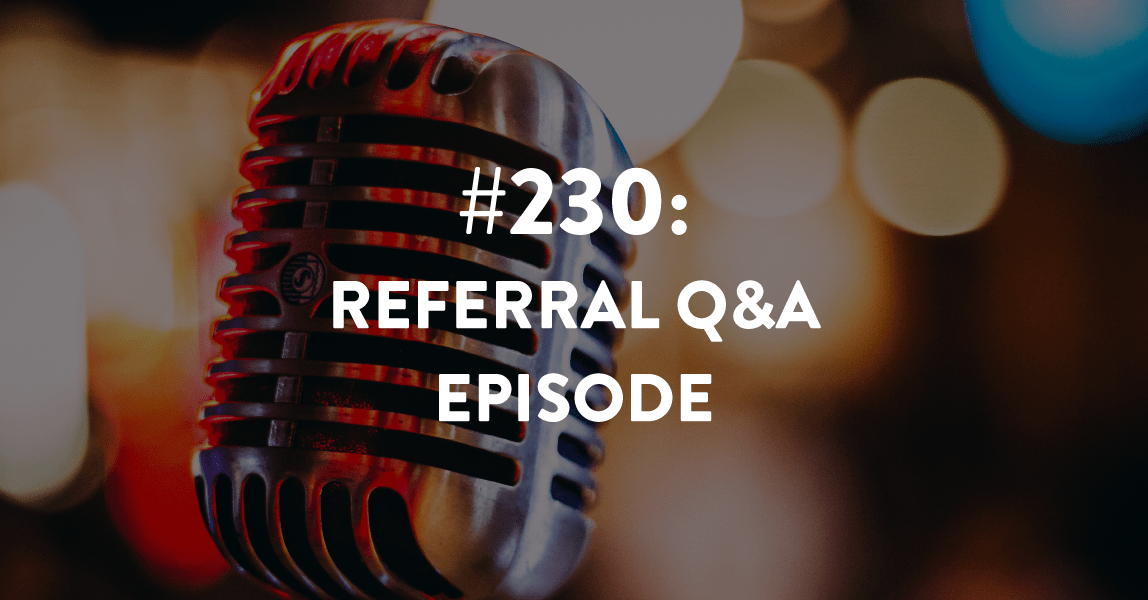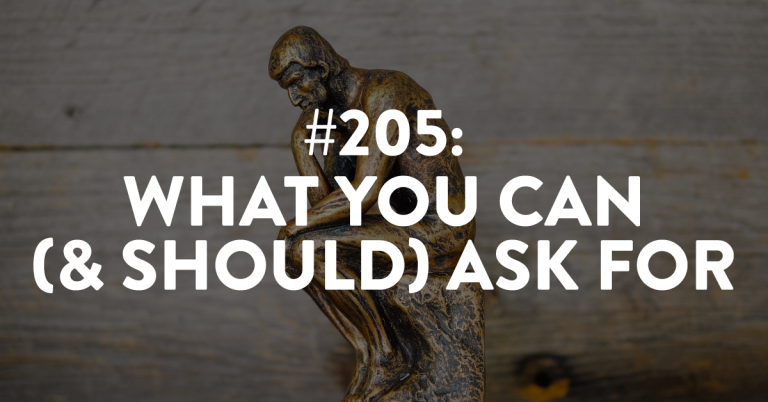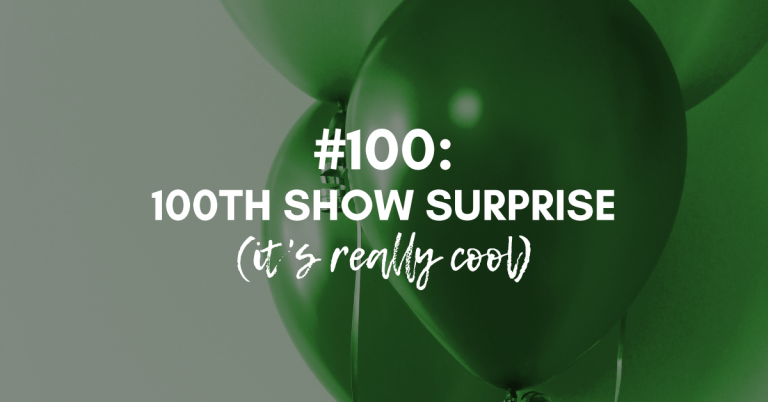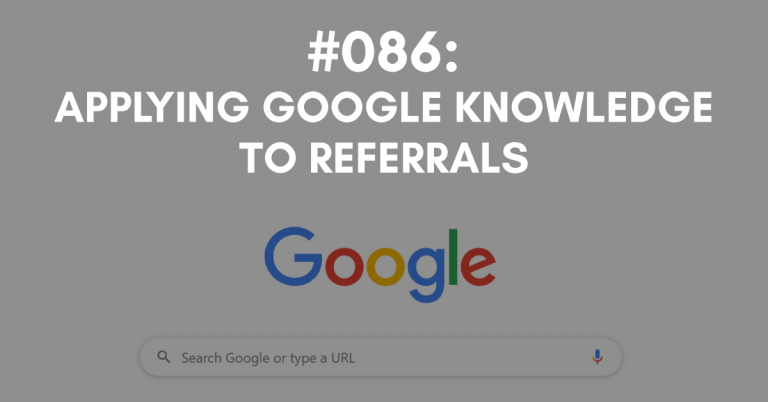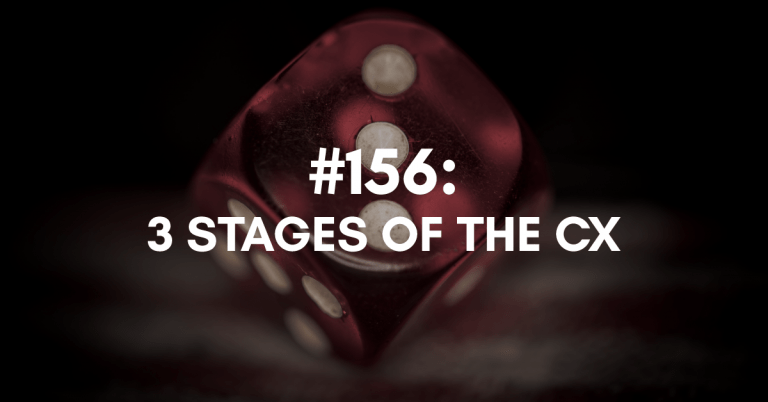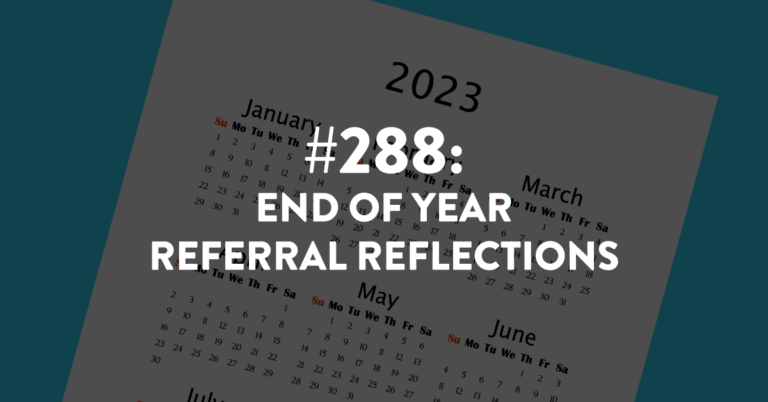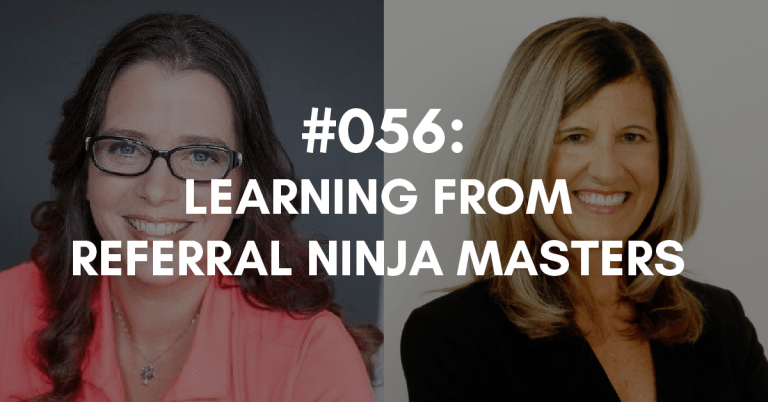Ep #230: Referral Q&A Episode
In today’s Q&A episode, I’m answering two excellent questions about referral seed language and the difference between keeping in touch and being top of mind.
First I will share how the referral seed language that I teach works. Of course, it is how your customers feel about you and how you take care of them that makes a big difference in your referrals. However, it is also the language you use that will get them to think about referring you to others. It isn’t complicated and it’s not hard, but it is the piece that makes everything else I teach truly work in order to get more referrals, so I will go over why this is essential to a good referral strategy.
Next, I will discuss whether there is really a difference between keeping in touch with someone and staying top of mind with someone. The short answer is that there is a difference. The long answer? Tune in to find out! Hopefully, this episode will give you the tools you need to build a referrable business.
Links Mentioned During the Episode:
Download your Gratitude In Action BINGO card now and start playing!
Get one of the last remaining spots at the Re:Focus Retreat! Registration and Agenda are included in the link.
What’s Coming Up:
Are you playing Gratitude in Action BINGO with me!! If you are – please show off the completed squares from your board by tagging me on social media – most places as staceybrownrandall or staceybrandall – and using the hashtag #gratitudeinaction and #gratitudebingo.
If you’re not playing and want to join us in spreading gratitude to small business owners all month long – then download your BINGO card at www.staceybrownrandall.com/thanks.
Remember, it’s easy to play..left to right, up and down, diagonal, the whole BINGO board. Pick a daily challenge – make it happen – mark the square once you did it – and keep going.
Looking for Referral Resources:
Take the Referral Ninja Quiz to test your skills and abilities at generating referrals. (FREE)
Buy my book – Generating Business Referrals Without Asking – and learn how to generate referrals through my 5 steps. (LESS THAN $16)
Check out our free resources on our Freebie Page. We have broken the free resources into two sections, based on if you’re less than 2 years in business or more than 2 years in business. Enjoy!
Consider joining Building a Referable Business™ – a unique way to learn all of my referral strategies and tactics with ongoing weekly access to me to answer your questions and help hold you accountable! Check it out and submit your application today!
Next Episode:
Next episode is #231, and I’m talking about the 3 things you need to do for your referral sources before the end of the year.
Download The Full Episode Transcript
Read the Transcript Below:
Stacey Brown Randall: Every 10th episode means question and answer time, and I’m answering two excellent questions about referral seed language and the difference between keeping in touch and top of mind. Let’s dive in.
Hey there, and welcome to episode 230 of the Roadmap to Grow Your Business podcast, a show about helping you build a referable business. I’m your host, Stacey Brown Randall.
I love our question-and-answer episodes because I get to dig in to exactly what you are thinking because, of course, you ask the questions, so I know exactly what you’re thinking.
I love it when you guys submit questions, whether you’re doing that through our free Facebook group, which is called Referrals Without Asking. If you’re not a member and you’re listening to this podcast, I hope you join.
Because you can always hop in there and get welcomed in our welcome post and tell us a little bit about you, but also, ask the questions that you have about referrals. And I love taking the opportunity to answer the questions that are either answered or asked in that group, or that are asked over email, or sometimes, just when people come up to me, if they see me at an event or something like that and they send me a direct message, whatever, and they ask their questions.
Now, typically, I love to answer the question for you in the moment, but lots of times, I’ll tell you, “Hey, that’s a great question, and I would love to answer that in more detail on the podcast.” Because then of course, I have a little bit more time and space.
So, we have two excellent questions today. One is about the language that you hear me talk about, and the other one is about this “keep in touch” versus “top of mind” concept that I talk about as well. So, I’m going to give you some great answers that you can use as you move forward.
But here is the one thing I want you to understand. When you’re thinking about how I’m answering these questions, just remember that sometimes these questions are being asked when somebody may be a little further along than you are in their referral journey.
So, I’ll try to stop and back up and give some context, but sometimes, my ability to answer the question correctly for the person who asked it, but also for the benefit of all of you as my listeners, is that sometimes they’re just a little further along and they have a little bit more understanding about what I’m talking about, which is why they have their question and my answer is for them.
So, what I want you to keep in mind is if I give an answer, well, in this episode of course, but in any episode in the future where it feels like I’m a little further ahead than where you are, then just ask a question.
Because at the end of the day, I want to make sure you have the knowledge and information you need to believe that it is possible to generate referrals naturally.
Now, you may not have all the answers to know exactly what to do. That’s okay. That’s why I have a business, that’s how I help people. And so, I’m always here to help you go to the next level if you’re interested in working with me. But just remember because these are two, they’re not slightly advanced questions.
I wouldn’t say it that way, but they are questions from people who have been listening to my podcast or have read my book or have been a part of my world and they’re just starting to dig in with these questions a little bit deeper to truly understand what they’re looking at when I talk about the advice and the resources and the education material that I provide.
So, just want to give a little context around these questions, and then of course, how I’m going to answer them. Because I will try to stop and go up to the 30,000 foot view before I kind of zone in on or I guess narrow in on the answer.
So, here’s the first question; the first question was why does the referral seed language that you teach work? So, the question is why does the referral seed language that I teach work.
If you’ve been a longtime listener of this podcast, you have heard me talk about the referral seed language. You’ve probably also wondered exactly what it is and what is the formula that I teach around it and the examples of it.
And we’ve talked about examples of it, and most of you understand this and this actually probably doesn’t bear repeating, but I’m going to repeat it anyway, as you know, this is the piece that I talk about as the secret sauce that I provide to my clients.
That I help them understand how powerful the language is and exactly what that language is, which is why when people work with me, whether it’s in one of my online programs or in my group coaching experience, BRB (Building a Referable Business), we talk a lot about language.
And in all of my programs, that’s why there’s dozens and dozens of scripts that you can take and use and modify for your own. Because I also know if you see it, then you can understand it better. And that’s what I want my clients to do.
So, you guys know, again, as a longtime listener of the podcast, that this is something that I talk about from a conceptual perspective here on the podcast, but very, very tactical in nature for my clients that are in my programs because ultimately, that’s one of the missing pieces that they want to clearly get right as easy and fast as possible, which is why of course, they’re willing to work with me and it’s why I’m able to help them.
But I love that this question was asked because I think it helps people understand that this isn’t throwaway language that I teach. That this isn’t just the, “Oh, hey, say thank you 50 million times for them referring to you.” It’s not that simple either.
It’s not complicated, it’s not complex, and it’s not hard, but it is the piece that makes everything else I teach work for the result we’re ultimately wanting, which of course, is more referrals or just to start receiving referrals.
So, the language piece really works, and I want to describe it. I want to answer that question by kind of explaining a story of a previous client of mine. So, I was working with a financial advisor, and this was years ago. I was working with a financial advisor.
And as you guys know, if you’ve been a longtime listener to the podcast or you’ve just consumed any of my resources, the way that I teach the strategy of using the language — it’s when you’re cultivating somebody who’s never referred you into a referral source. And it’s also using that language when you are dealing with an existing referral source. Somebody who has referred you or is referring you to be able to get more referrals from them.
There’s a language component that works. Now, the truth is, out of all 18 of my strategies, the language is the biggest piece of all of them. But I’m just kind of breaking this down specifically into the two of the three foundational strategies.
And those two foundational strategies are existing referral sources, what do you do to get more referrals from them? And potential referral sources, what do you do to get somebody to refer you for the very first time.
And of course, as you can imagine, there’s two major components there and that is number one, that first component is it’s how they feel about you. It’s how you take care of them. But it is also the language that you use while you’re taking care of them, which gets them to think about referring you.
Now, inside my programs, there is actually a formula. It’s like a three-part formula we teach about, like what you should make sure your language always has. So, when you’re doing a touchpoint to a referral source or you’re writing that thank you note, or you’re in a networking opportunity and you’re having a one-on-one conversation with a potential referral source, there’s a breakdown of a formula that we teach.
And it’s pretty simple because I know that whatever is simple, my clients will actually do. So, we try to keep everything as simple as possible. But there’s like a formula that we use so they can always come up with their own language.
Because what’s most important to me with my clients is not that they can take the language and the examples and the samples and the scripts and everything that I give them, but they can take those and they can modify them for themselves and then when they’re in the moment, they can come up with their own language.
That is that moment when I feel like the grasshopper becomes the master, and that’s ultimately what I’m looking for with my clients. And so, when people wonder about this language piece, this referral seed, which is what we call it — this referral seed language piece, it isn’t used separately from the rest of the strategy that I teach. Actually, it’s the piece of the strategy that makes the strategy work. But you can’t just use it separately. Like it actually fits with the other strategies.
So, I was working with this financial advisor. I know some of you were like, “Is she ever going to get back to that story she started?” I’m coming, I promise. Okay, here we go.
So, I was working with that financial advisor who did a lot of what I would refer to as client experience type outreach or touchpoints.
And in this case, obviously this is a number of years ago, so obviously, this was pre-covid and he did a lot of client experience events. And as he was going through my system and my strategy, and I really do believe that sometimes people are looking for the shortcut and sometimes it is the shortcut that is ultimately what fails.
And so, in this case, he was like, “Well I’ve got all these client experience events and outreaches that I do, I’ll just start inviting my referral sources to them.” And I told him that’s not going to work. And I know for most people sitting there are like, “But it’s so easy if it did work.” I know, I know. And if it worked that’s what I would teach.
But the truth is that’s not ultimately just inviting your referral sources to your client appreciation events or your client appreciation outreaches or whatever you do in your client experience, and then applying that to your referral sources isn’t actually going to get you more referrals because it’s missing the language piece.
And that’s the conversation that he and I had. I said, “Well, you can do that, but if you’re not using the language component as a part of that and specifically as a part of that for your referral sources in those moments, it’s not actually going to produce more referral results for you. It’s not going to produce more referrals for you.”
And that’s what he came to learn as well. And it’s a hard lesson I never want anyone to learn. But the language piece is actually what helps people trigger their thoughts in their mind. So, this is the one thing I want you to understand about how my strategies work and how we spend — well, we’ve been doing this for 10 years now.
But how early on I spent a lot of time figuring out what was working and was not working based on the science piece behind it and the understanding how people respond and the understanding yes, it’s this concept of be a good human, but it’s also this concept of how we have people thinking and how we are taking care of them.
And so, one thing that you’ve probably heard me say this before — if not, this will not be the last time you hear me say it or the first time you hear me say it. When your referral sources … I’m talking specifically to people who’ve referred you before, so your referral sources means they’re existing, they have referred you before.
When you are taking care of your referral sources, you’re able to impact how they feel about you. Like if you’re multitasking, come back to me because this is like a really important piece.
When you are taking care of your referral sources through the outreach or the touchpoints that we talk about, you’re impacting how they feel about you, they feel taken care of. They don’t feel like they’re taken for granted. They know you appreciate them. Like that’s the whole point of taking care of them with the outreach that we do, which is that memorable and meaningful outreach that I talk about doing.
When you’re taking care of them and you’re impacting how they feel about you, that is then your opportunity to direct how they think about you. And as long as you are doing it in a gratitude-filled way, in an authentic-filled way, in a thankful way, it will always feel normal and right because you’re doing it for all the right reasons.
And that’s really important, and that’s really important for you to understand and for you to make sense of exactly how the referral seed language works. And it comes down to this very simple concept.
If you’re impacting how people feel about you, then you can be able to impact how they think about you. And so, when I teach my clients to plant referral seed language, it’s in those moments that it’s able to work with how we’re taking care of our referral sources.
So, you can take care of your referral sources all day long, and maybe that’ll trickle in some referrals, but not probably the consistency you’re looking for because you’re missing the language piece.
And you can say referral seed language all day long, but if you’re not saying it in the right moments to the right people with the right context, coming from a gratitude-filled place and not so much just let me just throw these seeds out there and see what happens, then it’s not going to work either. It’s these two pieces coming together.
So, when the person asks the question, why does the referral seed language work that you teach? It’s not because I teach it in a vacuum, it’s because I teach it based on the science of how we’re impacting how other people feel because it’s coupled with how we’re taking care of them and how we’re cultivating and deepening and strengthening those relationships.
And we use pieces of that language to also then cultivate new people referring us. And we use pieces of that language also within our client experience so that there’s moments to start getting our clients to think about potentially referring us. And then of course, it’s all throughout a lot of the other script tactics or script strategies that I teach as well.
This is like a well-oiled machine that has been proven to work for almost a decade now, but it has proven to work because we’re doing all the pieces together. And I can clearly tell when I’m working with someone if they’re not going to actually implement a part of the process, why it’s not going to work for them. And I can clearly say, because you chose not to do this piece, the rest of it just didn’t work the way you wanted it to.
There are a lot of people, like when I’m onboarding somebody new within Building a Referral Business, the group coaching experience — when I’m in there one-on-one onboarding session when they’re first starting, we talk about obviously strategy stacking of what strategies they’re going to implement first and what that ultimately looks like.
We talk about how to use the portal so they know where to find everything. They get a good onboarding, but then we also talk a little bit about what their immediate need is. Outside of that first strategy that they’re going to learn, like are they’re finding themselves in situations where they need like an immediate solution. And I always leave space to talk about that.
And usually (not always) — but usually, they’re like, “Well, I was thinking about I could apply some of the stuff I’m going to learn from you to this situation.” And then I’m able to like unpack them with that.
I’m like, “Actually, what I would tell you to apply in that situation is X, Y, Z, like language tactic, strategy, whatever.” And they’re always like, “Oh my gosh, that’s going to make all this worth it.”
And it came in like a five-second answer, the very first conversation we had of what is about to be a 12-month engagement with me and them. But they’re like, “Oh my gosh, I never would’ve thought to say it that way.”
Because there are little things that can make everything better. But holistically, if you want this strategy to work the way that I teach it, you got to put all the pieces in place, and the language piece is just as important as how we take care of our referral sources and all those components going together.
So, it was an excellent question. For those of you who are like, “This is the first time I’ve ever listened to your podcast, and I have no idea what you’re talking about.” That’s because this is a little bit further along in terms of what I teach in terms of understanding the strategy and the steps for how we generate more referrals. But go back and listen to some other podcast episodes. Don’t worry, you can easily get caught up.
But that is why, and I’m so glad this question was asked so that I could talk about why the language piece that I teach works to getting us the results we want, which of course, are more referrals.
Pardon the interruption. Are you playing Gratitude In Action BINGO with me? If you are, please show off the completed squares from your bingo board by tagging me on social media. Most places you can find me at Stacey Brown Randall, or in some cases at Stacey B. Randall.
And use the hashtag, #gratitudeinaction and #gratitudebingo. That way, I can find you and celebrate with you as you are going through and completing the challenge of Gratitude In Action BINGO.
But hey, if you’re not playing Gratitude in Action BINGO with us, which is really just sharing gratitude for other small business owners throughout the month of November — if you’re not playing Gratitude in Action BINGO with us and you want to join in, then you just need to download your bingo card and get started.
Nothing’s stopping you, but you just need to go to staceybrownrandall.com/thanks and download your BINGO card and then get started.
Whether you’re listening to this at the beginning of the month or the end of the month, it doesn’t matter. It’s never too late to spread some gratitude to other small business owners. And remember, it is easy to play left to right, up and down, diagonal the whole BINGO board, win as many times as you want.
Just pick a daily challenge, one little challenge in a square, make it happen and mark that square once you’ve done it, and then keep going. I would love for you to play Gratitude in Action BINGO with me. Go to staceybrownrandall.com/thanks to play.
Okay, back to the episode. Here’s our next question that I was asked that I’m super excited to answer; “Is there really a difference between keep in touch and top of mind?” Is there really a difference between keeping in touch with someone and top of mind, which is what I teach within my strategies?
Short answer, yes. Longer answer do explain it, okay.
Keeping in touch is typically the things that we do. It’s typically defined today as the things that we do that just kind of hit someone’s radar quickly because we’re just trying to keep in touch. It’s the email you send to say, “Hey, how are you doing? Or you were on my mind.”
It’s the e-newsletter you send out once a week or once a month that lets people know what’s going on in your world. Those are different actions that we take that are us trying to keep in touch with maybe our clients, with maybe our prospects, with our email list, with our database of humans.
There are things that we do that are keeping in touch and they typically, or what I like to refer to as, the short term memory because they’re quickly forgotten. I know that’s kind of painful if you spend a lot of time writing that newsletter every week or every month, but they sometimes are easily forgotten because of the delivery channel of keeping in touch.
Keeping in touch as a delivery channel is typically email or text message and sometimes even a phone call, because those things happen and then they’re over in a moment, which is very different than what I teach.
If you’re going to actually want to take care of your referral sources and plant that important referral seed language we just talked about with the first question of this episode, then you’re going to need a strategy that moves past, that transcends past, keeping in touch and goes to top of mind.
The what you do dictates how much space in your referral sources’ mind you take up. The what you say while doing it defines how they think about you in those moments, meaning more referrals. So, top of mind is actually the ability to do less outreach but more memorable and meaningful outreach in the moment so that it is remembered longer.
When I teach people to put together their referral plan for their existing referral sources, not potential referral sources. But when they put together their plan for their existing referral sources of how they’re going to take care of their existing referral sources and give them opportunities to plant those ever important referral seeds, we talk about keeping top of mind.
And top of mind means looking at it from the framework, like so there’s a four-part framework that I teach my clients about how we build out our referral plan. We’re not just willy-nilly saying, “I’m going to write a card and then I’m going to take people to coffee and yay me.” Like we’re just not willy-nilly pulling things out.
There’s actually a framework, and it’s actually based on a science. You guys hear me talk about the science behind generating referrals naturally, this is a big part of where it actually exists, is how we take care of them.
And so, when we’re looking at that four-part framework, there’s this piece of that four-part framework that talks about the memory runway. And some of the things you do from a memory runway perspective the way that I teach it to my clients, are just remembered longer. It impacts the memory longer.
That text message is quickly forgotten once it’s buried under the next 20 text messages. That email is quickly forgotten once it’s read and deleted because the average American is getting 167 emails in a day. So, they’re easily forgotten and overlooked.
And I don’t know what it is around the world, but I’m pretty sure we can all assume most people are receiving around a 100 to 200 emails a day. So, just by the very nature of the keep-in-touch delivery mechanisms, things are seen and forgotten.
When we’re top of mind, we’re doing things a little bit differently. There is a variety to how we do things and there is this concept of recognizing that what we do, if it is memorable and meaningful, and we’re doing it with the right cadence, but not too often.
And this is huge — not too often, it allows us to actually occupy more space in the mind of our referral sources because it’s hitting on the gratitude piece of how we take care of them and knowing how much we appreciate them and the language piece of what we’re so appreciative of them doing.
Though you just can’t always just say, “Thank you for referring me.” Like you’ve got to know how to do some variety to your language that allows us to stay top of mind with our referral sources.
That doesn’t mean like your referral source is going to wake up every day and think, “I’m thinking of Stacey today.” They don’t do that. We wake up thinking of ourselves, let’s be honest.
But at the end of the day, when you take better care of your referral sources from a top of mind perspective and not a keep in touch perspective, and you’re being memorable and meaningful and you’re using the right language, that is when all the pieces come together and the process works.
So, when you hear me talk about taking a client of mine who is an attorney who averaged 12 referrals a year before working with me, and then that attorney, working through the process, and then their very first year receiving 40 referrals, that’s the difference.
Averaging 12 all by themselves, great. Good job. Now, getting 40 plus now actually five years later, getting 80 plus referrals in a year is because they implemented strategies for that. And these are pretty simple strategies, but they are based on the right formula.
And there’s a lot of frameworks and formulas that I teach so that people understand why they work, how they work, and then of course, how to build their own. And that, of course, is my everyday joy to help my clients figure out.
So, there you go. That is the answer to the question; “What is really the difference between keeping in touch and top of mind?” Because yes, my friend, they are very, very different.
I want to thank the listeners who submitted questions for today’s episode. If you want me to answer your question on an upcoming episode, please just shoot me an email or direct message me with your questions. We’ll have another Q&A episode coming up in just 10 episodes.
Everything mentioned on today’s episode can be found on the show notes page and this episode’s show notes page is staceybrownrandall.com/230. That’s for episode 230 — staceybrownrandall.com/230.
By the way, it’s not too late to join me in December in Charlotte for our Re:Focus Retreat. I’ll be walking you through my reverse goal setting methodology, and because we’re keeping the group small, you and I will be chatting about your goals specifically.
This is an intimate event, not a ballroom full of people, and there are just a few seats left. You can snag your seat before the deadline at staceybrownrandall.com/goals — staceybrownrandall.com/goals. So, of course, I’d love to see you in December.
Coming up next week is episode 231, and I’m talking about the three things you need to do for your referral sources before the end of the year. It’s a very important episode, do not miss it.
Until then my friend, you know what to do; take control and grow your business. Bye for now.
Thanks for listening to the Roadmap to Grow Your Business podcast. To
access all resources and links mentioned in today’s show, and to
connect with Stacey, head over to www.staceybrownrandall.com.

